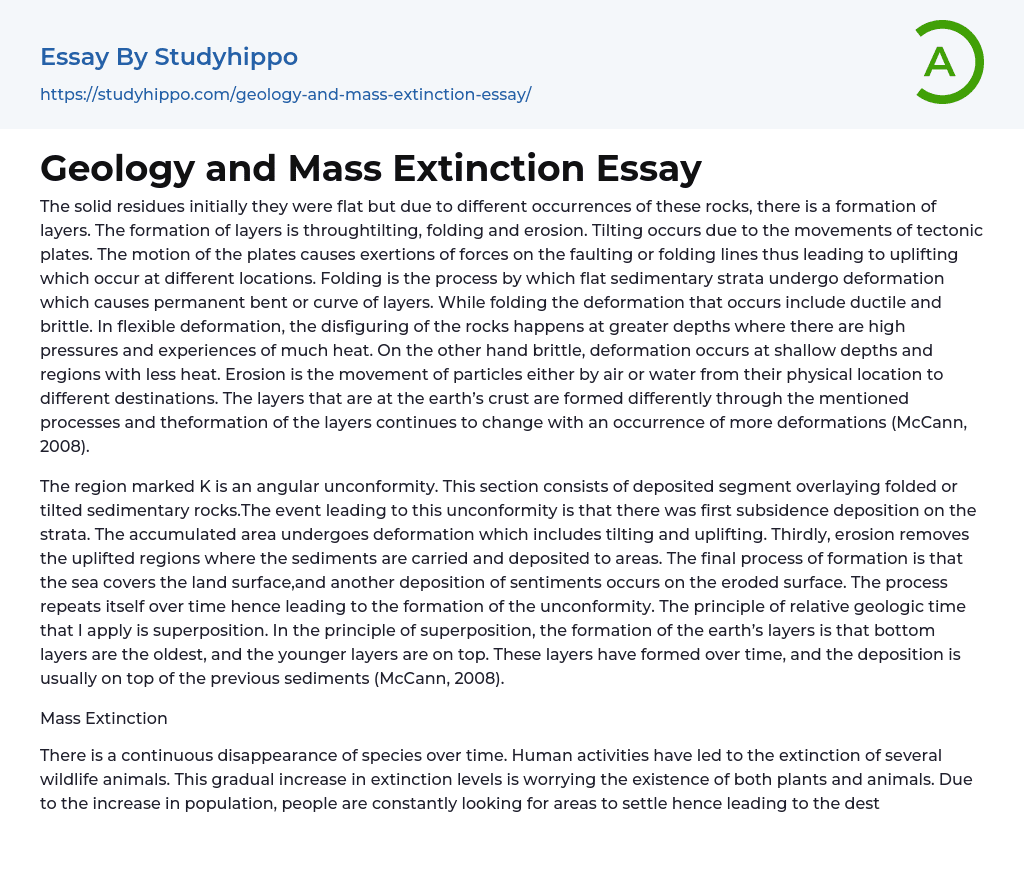The solid residues initially they were flat but due to different occurrences of these rocks, there is a formation of layers. The formation of layers is throughtilting, folding and erosion. Tilting occurs due to the movements of tectonic plates. The motion of the plates causes exertions of forces on the faulting or folding lines thus leading to uplifting which occur at different locations. Folding is the process by which flat sedimentary strata undergo deformation which causes permanent bent or curve of layers. While folding the deformation that occurs include ductile and brittle. In flexible deformation, the disfiguring of the rocks happens at greater depths where there are high pressures and experiences of much heat. On the other hand brittle, deformation occurs at shallow depths and regions with less heat. Erosion is the movement of particles either by air or water from their physical lo
...cation to different destinations. The layers that are at the earth’s crust are formed differently through the mentioned processes and theformation of the layers continues to change with an occurrence of more deformations (McCann, 2008).
The region marked K is an angular unconformity. This section consists of deposited segment overlaying folded or tilted sedimentary rocks.The event leading to this unconformity is that there was first subsidence deposition on the strata. The accumulated area undergoes deformation which includes tilting and uplifting. Thirdly, erosion removes the uplifted regions where the sediments are carried and deposited to areas. The final process of formation is that the sea covers the land surface,and another deposition of sentiments occurs on the eroded surface. The process repeats itself over time hence leading to the formation of the unconformity. The principle
of relative geologic time that I apply is superposition. In the principle of superposition, the formation of the earth’s layers is that bottom layers are the oldest, and the younger layers are on top. These layers have formed over time, and the deposition is usually on top of the previous sediments (McCann, 2008).
Mass Extinction
There is a continuous disappearance of species over time. Human activities have led to the extinction of several wildlife animals. This gradual increase in extinction levels is worrying the existence of both plants and animals. Due to the increase in population, people are constantly looking for areas to settle hence leading to the destruction of natural habitats. The clearing of forests to create land for settlement has eradicated the survival of animals as well as plants. Scientific evidence shows that a big chunk of these domains is extinct. There are evident signs of looming mass extinction. For example, the dinosaurs have vanished from this earth and they are no more. The auks are also believed to have disappeared, and fishermen killed the last of them for their expensive meat. Furthermore, the few existing animals can only be found in the zoo. Some of these endangered species include the Lemurs and this is evident that their existence is in danger (Kolbert, 2014).
There is no concrete evidence against mass extinction. However, there have been written research papers which try to disapprove the anticipated sixth mass extinction. The disapproval attempts to show that the decline in the population of wildlife is the main problem. The difference between the past and present situations is that the rate of extinction is high at the present than the
past. There is a sharp increase in the pace at which we are losing the species. Another difference is the way the species are evolving to keep pace with the loss, and it has really increased over time (Kolbert, 2014).
References
- McCann, T., & Geological Society of London. (2008). The geology of Central Europe. London:Geological Society.
- Kolbert, E. (2014). The sixth extinction: An unnatural history.
- Air Pollution essays
- Carbon Dioxide essays
- Climate essays
- Deforestation essays
- Ecology essays
- Endangered Species essays
- Environmental Issues essays
- Environmental Protection essays
- flood essays
- Greenhouse Gas essays
- Hurricane essays
- Nature essays
- Pollution essays
- Renewable Energy essays
- Sustainability essays
- Tornado essays
- Traffic essays
- Tsunami essays
- Water Pollution essays
- Agriculture essays
- Albert einstein essays
- Animals essays
- Archaeology essays
- Bear essays
- Biology essays
- Birds essays
- Butterfly essays
- Cat essays
- Charles Darwin essays
- Chemistry essays
- Dinosaur essays
- Discovery essays
- Dolphin essays
- Elephant essays
- Eli Whitney essays
- Environmental Science essays
- Evolution essays
- Fish essays
- Genetics essays
- Horse essays
- Human Evolution essays
- Isaac Newton essays
- Journal essays
- Linguistics essays
- Lion essays
- Logic essays
- Mars essays
- Methodology essays
- Mineralogy essays
- Monkey essays




